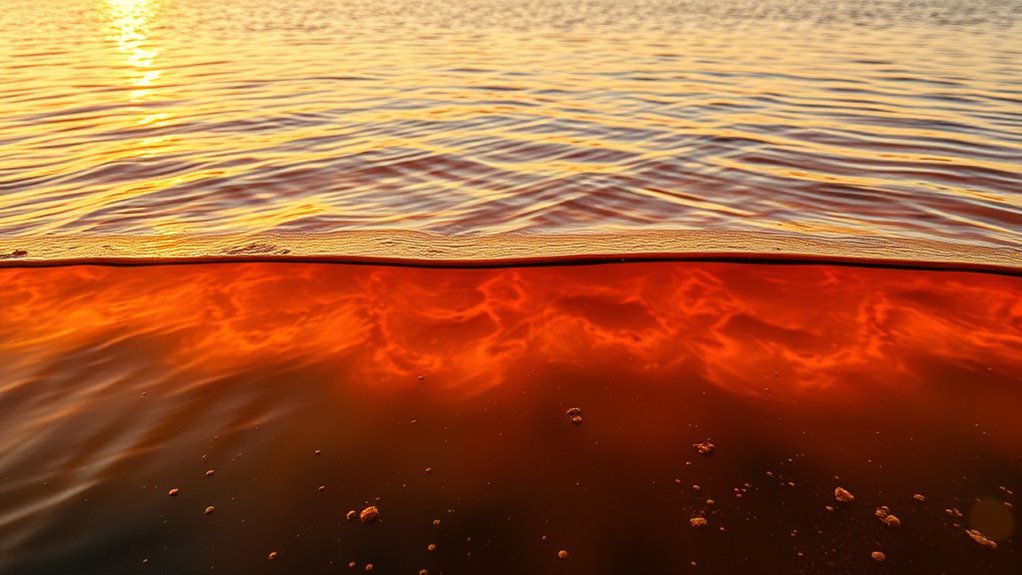During heat waves, you’ll notice surface water temperatures rise rapidly, causing the upper layers to warm quickly. This creates a strong thermal stratification that prevents mixing with deeper water, trapping nutrients and oxygen in different layers. As a result, floating debris and algae can become more prevalent, and oxygen levels drop in the lower layers. If you want to understand how these changes affect aquatic life and water quality, keep exploring further.
Key Takeaways
- Heat waves cause rapid surface water warming, strengthening thermal stratification and creating distinct temperature layers.
- Increased stratification reduces vertical mixing, preventing nutrients and oxygen from circulating between layers.
- Oxygen levels decrease in deeper layers as organic matter decays, leading to hypoxia or anoxia.
- Floating debris and algae blooms intensify due to higher surface temperatures and nutrient buildup.
- Stronger stratification and organic decay promote dead zones, deteriorating water quality and harming aquatic life.

Heat waves are increasingly affecting water layers in lakes and oceans, disrupting aquatic ecosystems and threatening water quality. As temperatures soar, the upper layers of water warm rapidly, leading to a process called thermal stratification. This occurs when a distinct temperature gradient forms between the warm surface water and the cooler, denser water below. During a heat wave, this layering becomes more pronounced, making it difficult for mixing to occur naturally. Without proper mixing, nutrients and oxygen don’t circulate effectively, which can have serious consequences for aquatic life.
One of the most critical impacts of intensified thermal stratification is the decline in dissolved oxygen levels in the deeper water layers. Normally, oxygen from the atmosphere dissolves into the water and is redistributed through mixing, supporting fish, invertebrates, and other aquatic organisms. However, when thermal stratification intensifies, the oxygen-rich surface water stays separated from the lower layers, preventing oxygen from replenishing the deeper zones. Over time, the lack of oxygen in these layers creates hypoxic or even anoxic conditions, which can cause fish kills and reduce biodiversity. When oxygen levels drop, it’s often irreversible, disrupting entire food webs and ecosystem balances.
Intensified stratification causes oxygen depletion, leading to hypoxic zones and irreversible damage to aquatic ecosystems.
You might notice that during heat waves, the surface water becomes warmer and less hospitable for many species, but the real danger lurks beneath. As the lower layers become oxygen-depleted, aquatic organisms are forced into a shrinking habitat, often leading to stress and mortality. The reduced oxygen also hampers microbial processes necessary for breaking down organic matter, causing organic material to accumulate and further degrade water quality. This cycle can lead to the formation of dead zones, where life becomes unsustainable. Additionally, increased thermal stratification can also hinder the natural breakdown of pollutants, exacerbating water contamination issues.
Floating matter and algae blooms can worsen these effects. Elevated temperatures promote the growth of algae, which, when they die, settle into the lower layers and decompose, consuming even more oxygen. The combination of thermal stratification and increased organic decay creates a vicious cycle that further depletes dissolved oxygen and destabilizes the water column. As a result, the water’s physical and chemical properties shift, making the environment inhospitable for native species and complicating water management efforts.
Frequently Asked Questions
How Do Heat Waves Affect Aquatic Plant Life?
During heat waves, you’ll notice aquatic plant life suffers as photosynthesis slows down due to higher water temperatures. This stress hampers their growth and energy production. Additionally, the root zone experiences stress because the warmer water reduces oxygen levels and disrupts nutrient absorption. As a result, plants weaken, leading to declines in underwater ecosystems and affecting the entire aquatic food chain.
Can Heat Waves Cause Water Bodies to Evaporate Completely?
Yes, heat waves can cause water bodies to evaporate considerably, sometimes even completely. As temperatures spike, evaporation rates accelerate, leading to increased water loss. While it’s unlikely for an entire large body of water to vanish completely, smaller ponds or shallow lakes may dry up entirely during intense heat waves. You’ll notice shrinking water levels and exposed lakebeds, emphasizing how vital it is to manage water resources during extreme heat.
Do Heat Waves Influence the Oxygen Levels in Water Layers?
Yes, heat waves influence the oxygen levels in water layers by causing oxygen depletion. As temperatures rise, thermal stratification occurs, creating distinct warm and cold layers that limit oxygen mixing. This reduces oxygen availability in deeper layers, harming aquatic life. You might notice fish and other organisms struggling to survive during prolonged heat waves due to these changes, highlighting the importance of understanding thermal stratification’s role in oxygen dynamics.
How Quickly Do Water Layers Respond to Rising Temperatures?
When temperatures rise, water layers respond quickly, often within days. Imagine a lake experiencing thermal stratification as summer heats it; the upper layer warms rapidly while the deep remains cooler. This process involves temperature diffusion, where heat slowly moves downward, but the initial response is swift. You’ll notice surface temperatures spike first, creating distinct layers that can influence oxygen levels and aquatic life.
Are Certain Water Bodies More Vulnerable to Heat Wave Impacts?
Yes, certain water bodies are more vulnerable to heat wave impacts. Lakes and shallow ponds experience stronger thermal stratification, making their water column stability more fragile. When heat waves occur, these bodies struggle to mix layers, leading to oxygen depletion and habitat disruption. You’ll notice that shallow lakes heat up faster and are less resilient, increasing the risk of harmful algal blooms and ecosystem stress during extreme heat events.
Conclusion
As heat waves continue to intensify, the future of our water layers and floating ecosystems hangs in the balance. Will these rapid changes trigger unforeseen consequences, or can we find ways to protect our waters before it’s too late? The stakes are higher than ever, and only time will tell what effects lie just beneath the surface. Stay alert—what happens next could reshape the very world you’re part of.










